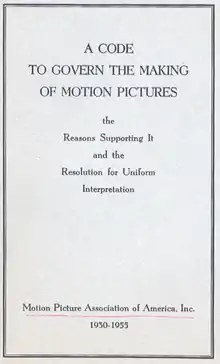Gay media
Gay media refers to media that predominantly targets a gay or lesbian audience. The primary target market for gay media may also more broadly be considered to include members of a LGBTQ+ audience.[1] Representation in gay media is something that is important to consider because of stereotypes that popular media has used to characterize LGBTQ+ people. Gay or queer media can be defined as web sites, films, magazines and other cultural products that were created by out queer people.[2] Gay creators do not always include gay themes or issues in their productions but there is usually at least subtle references to queerness in this media.[2] There have been both positive and negative representations of gay people in different types of media such as film, television, literature and press. Representation in the media is powerful and therefore, invisibility in media keeps the powerless groups at the bottom of our social hierarchy.[3] There have been studies that have shown that media can have an influence on LGBTQ+ people's self-realization, coming out and current identities.[4]
| Part of a series on |
| LGBT topics |
|---|
| lesbian ∙ gay ∙ bisexual ∙ transgender |
|
|
Film
Hollywood has a complicated history with gay representation, evidenced by the Motion Picture Production Code which was an industry guideline to self-censor all major motion pictures from 1934 to 1968. Gay invisibility in media was a by-product of this Production Code that was held in place for more than 30 years. However, even in the 1960s and 1970s when gay representation was becoming more visible, it was also becoming more homophobic. Gay characters in this time period were represented very negatively whether that meant they were dangerous and suicidal or predatory and violent in such movies as The Children's Hour, The Boys in the Band, Midnight Express, and Vanishing Point [5]. In the 1990s, films such as The Birdcage, Philadelphia, To Wong Foo Thanks for Everything, Flawless and In & Out were quite popular and proved that audiences were eager for gay representation. In 2005, Brokeback Mountain grossed over $178 million and in 2017, Moonlight won the Academy Award for Best Picture along with countless other awards. Gay representation is now quite commonplace in film so it is now more important to analyze how accurate and beneficial these representations actually are. The gay man and heterosexual woman couple has become a genre itself in popular culture which does bring more mainstream visibility for gay men. This coupling exists in popular films such as My Best Friend's Wedding, The Object of my Affection, and The Next Best Thing. Some scholars argue that homosexuality is recoded and modified in these films to approve sexism as well as heteronormativity.[6]
Television

According to The Los Angeles Times, gays are so present on television because they are so present in television, meaning that gay people have always been somewhat integrated into the hierarchal structure of Hollywood[3]. However, this does not mean that all gay people in Hollywood were out, as the Code of Practices for Television Broadcasters indirectly prohibited positive homosexual representation from 1952 to 1983. In 1997, Ellen became the first show to have a gay main character.[7] After this, there was an increase in shows that included recurring gay characters such as Will & Grace, Dawson's Creek, Spin City, ER, Buffy the Vampire Slayer, Nightline, Queer Eye for the Straight Guy, Queer as Folk, The Young and Restless, Ugly Betty and Glee. Reality TV shows have also frequently represented openly gay people, such as MTV's The Real World, CBS's Survivor and The Amazing Race.
See also
- Gay news
- Gay community
- Gay marketing
- GLBT
- Homosexuality
References
- "Gay Images: TV's Mixed Signals". The New York Times. 1991-05-19. Retrieved 2010-10-24.
- "Queer Representation in Film and Television". MediaSmarts. 2012-03-07. Retrieved 2020-12-03.
- Gross, Larry (2001-12-26). Up from Invisibility: Lesbians, Gay Men, and the Media in America. Columbia University Press. ISBN 978-0-231-52932-7.
- MS, Sarah C. Gomillion; PhD, Traci A. Giuliano (2011-02-22). "The Influence of Media Role Models on Gay, Lesbian, and Bisexual Identity". Journal of Homosexuality. 58 (3): 330–354. doi:10.1080/00918369.2011.546729. ISSN 0091-8369. PMID 21360390. S2CID 37534112.
- "Queer Representation in Film and Television". MediaSmarts. 2012-03-07. Retrieved 2020-12-03.
- Shugart, Helene A. (2003-01-01). "Reinventing Privilege: The New (Gay) Man in Contemporary Popular Media". Critical Studies in Media Communication. 20 (1): 67–91. doi:10.1080/0739318032000067056. ISSN 1529-5036. S2CID 29622909.
- Cook, Carson (2018-05-01). "A content analysis of LGBT representation on broadcast and streaming television". Honors Theses.
This article incorporates material from the Citizendium article "Gay media", which is licensed under the Creative Commons Attribution-ShareAlike 3.0 Unported License but not under the GFDL.

